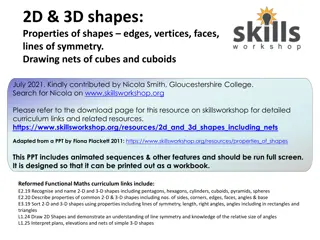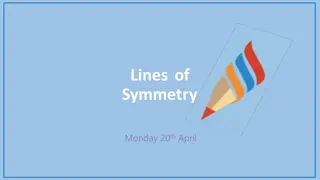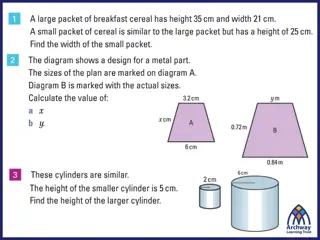Exploring 2D and 3D Shapes with Nets and Properties
Dive into the world of 2D and 3D shapes with a focus on properties, edges, vertices, faces, and lines of symmetry. Discover how to draw nets for cubes and cuboids, identify shapes, name 3D shapes, and understand mathematical definitions. Engage in activities that challenge your knowledge of shapes a
0 views • 16 slides
Understanding Spherical Mirrors: Concave and Convex Types, Image Formation, and Practical Uses
Spherical mirrors, including concave and convex types, play a crucial role in reflecting light. By exploring the properties of concave and convex mirrors, understanding image formation, and discovering their diverse applications in daily life, we can grasp the significance of these mirrors in scienc
0 views • 9 slides
Explore 3D Shapes: Properties and Examples
Unveil the fascinating properties of 3D shapes through engaging visuals and descriptions. Identify shapes based on their faces, edges, vertices, and unique characteristics like curved faces or square-based structures.
0 views • 17 slides
Shapes and Their Properties
Explore the properties of 2D shapes such as sides, vertices, and unique characteristics through engaging visuals and descriptions. Learn about common shapes like circles, triangles, squares, rectangles, pentagons, hexagons, and heptagons. Enhance your understanding of geometry in a fun and interacti
1 views • 17 slides
Mastering 2D and 3D Shapes Vocabulary from Reception to Year 5
Explore essential 2D and 3D shapes vocabulary for students from reception to Year 5, encompassing a variety of shapes such as cubes, pyramids, spheres, cones, cylinders, and more. The comprehensive list includes both two-dimensional and three-dimensional shapes, providing a solid foundation for unde
3 views • 9 slides
Identifying Sides and Vertices in 2D Shapes for Year 2 Geometry Session
In this geometry lesson, we explore various 2D shapes such as square, triangle, circle, rectangle, pentagon, hexagon, heptagon, and octagon. We learn about the number of sides and vertices each shape has, distinguishing between shapes based on their unique characteristics.
1 views • 10 slides
Understanding the Elements of Art: Point, Line, Shape, and More
Explore the fundamental elements of art presented by Mrs. Seema Jaitly, Assistant Professor for B.Sc. Home Science Sem.3. Discover how points, lines, shapes, sizes, spaces, textures, and colors form the basis of creativity. Delve into the types of lines such as vertical, horizontal, curved, and diag
1 views • 25 slides
Fractions and Shaded Shapes
Explore fractions by identifying shaded parts in different shapes. Learn about unit fractions with a numerator of 1, and practice determining fractions of shaded areas. Understand the concept of unit fractions and apply it to various scenarios involving shapes and fractions.
0 views • 21 slides
Shapes Recognition Activities for Students
Explore various 2D and 3D shape recognition activities including matching shapes to names, identifying shapes based on sides and faces, and sorting shapes into categories. Engage in fluency exercises to name and match shapes, reasoning challenges, and problem-solving tasks to enhance shape recogniti
0 views • 12 slides
Understanding Geometric Shapes through Visualization in Mathematics for Class 7
Explore the concept of visualising solids in mathematics for Class 7 students. Learn to associate 2D drawings with 3D shapes, visualize various solids, identify their properties, and develop skills in drawing sketches. The chapter covers learning objectives, recapitulation of shapes around us, intro
1 views • 35 slides
Mastering 2-D Shape Vertices: Learning Guide
Understand the concept of vertices on 2-D shapes, learn how to count vertices, identify shapes based on their vertices, and determine the odd one out in a group of shapes. Explore the number of vertices in various shapes like a triangle, rectangle, pentagon, hexagon, octagon, and even a circle. Test
5 views • 16 slides
Geometry Learning - Lines of Symmetry Activities
Explore various activities focused on lines of symmetry in shapes. Engage in identifying symmetrical shapes, finding lines of symmetry through folding, sorting shapes based on symmetrical properties, drawing lines of symmetry, and reasoning about symmetrical shapes. Enhance your understanding of sym
0 views • 16 slides
Calculate Area of Various Shapes - Geometry Challenges
Discover how to calculate the area of different shapes through hints and visual aids such as squares, rectangles, triangles, and more. Learn to find areas of composite shapes, missing triangles, and shapes with corners cut off. Practice working out areas based on dimensions provided in each scenario
0 views • 10 slides
Understanding Similarity and Congruence in Geometry
The difference between congruence and similarity lies in how shapes are compared. Congruent shapes are identical in size and shape, with equal side lengths and angles. Similar shapes have proportional side lengths and equal angles, appearing alike but not identical. Scaling factors play a crucial ro
0 views • 20 slides
Understand Convex and Concave Functions in Mathematics
Learn about convex and concave functions in mathematics, including how to differentiate between them, identify their characteristics, and analyze gradients. Explore the concepts with practical examples and visual aids. Enhance your proficiency in answering questions related to convex and concave fun
0 views • 15 slides
Generalization of Empirical Risk Minimization in Stochastic Convex Optimization by Vitaly Feldman
This study delves into the generalization of Empirical Risk Minimization (ERM) in stochastic convex optimization, focusing on minimizing true objective functions while considering generalization errors. It explores the application of ERM in machine learning and statistics, particularly in supervised
0 views • 11 slides
Exploring 2D Shapes and Sides in Mathematics
Dive into identifying and counting the sides of 2D shapes through informative practices like describing shapes by their sides, recognizing shapes by their side count, and solving engaging problems related to shapes and sides. Explore the properties of various polygons, such as squares, triangles, pe
0 views • 11 slides
Optimization Techniques in Convex and General Problems
Explore the world of optimization through convex and general problems, understanding the concepts, constraints, and the difference between convex and non-convex optimization. Discover the significance of local and global optima in solving complex optimization challenges.
0 views • 24 slides
Closest Pair and Convex Hull: Brute Force Approach
Closest Pair Problem in 2D involves finding the two closest points in a set by computing the distance between every pair of distinct points. The Convex Hull Problem determines the smallest convex polygon covering a set of points. Dr. Sasmita Kumari Nayak explains these concepts using a brute-force a
0 views • 15 slides
Understanding Convex Hulls in Computational Geometry
Convex hulls are a fundamental concept in computational geometry, representing the smallest convex shape that contains a set of points. The process involves defining the convexity of a set, determining the unique convex polygon, and computing the convex hull efficiently using algorithms. This conten
0 views • 9 slides
Algorithms: Convex Hull, Strassen's Matrix Multiplication, and More
Explore various divide-and-conquer algorithms including Convex Hull, Strassen's Matrix Multiplication, and Quickhull. Understand the concepts of Sorting, Closest Pairs, and Efficiency in algorithm design. Discover efficient techniques such as recursive calculations and simplifications to enhance alg
1 views • 20 slides
Exploring 2D Shapes: A Comprehensive Comparison and Classification
Discover various 2D shapes such as circles, polygons, quadrilaterals, squares, rectangles, kites, rhombuses, trapeziums, pentagons, hexagons, and octagons. Learn about their unique characteristics, number of sides, angles, and distinctions. Identify shapes based on the number of sides they possess,
0 views • 14 slides
Engaging English Lesson on Shapes and Rhymes for Second Graders
Explore an interactive English lesson for second-grade students focusing on shapes and rhymes. The lesson includes activities such as safety greetings, reviewing previous lessons, and reciting rhymes about shapes like circles and squares. Students will enhance their listening and speaking skills by
0 views • 16 slides
Exploring 2D Shapes and Polygons
Uncover the world of 2D shapes and polygons with a brain dump session, identifying common shapes like triangles, quadrilaterals, and polygons with Greek and Latin numerical prefixes. Learn the distinguishing features of shapes, symbols used to represent key characteristics, and how markings denote e
0 views • 27 slides
Insights into Recent Progress on Sampling Problems in Convex Optimization
Recent research highlights advancements in solving sampling problems in convex optimization, exemplified by works by Yin Tat Lee and Santosh Vempala. The complexity of convex problems, such as the Minimum Cost Flow Problem and Submodular Minimization, are being unraveled through innovative formulas
1 views • 47 slides
Convex Optimization: Interior Point Methods Formulation
This chapter on interior point methods in convex optimization explores the formulation of inequality-constrained optimization problems using barrier methods and generalized inequalities. It covers primal-dual interior point methods and discusses issues such as exponential complexity and determining
0 views • 24 slides
Understanding Scale Factors and Similar Shapes in Graphic Design
Graphic artists often need to resize shapes for different purposes while ensuring they maintain their original proportions. This involves determining the scale factor between similar shapes, understanding how to find the scale factor using corresponding sides, and dealing with scenarios where sides
0 views • 8 slides
Exploring Links Between Convex Geometry and Query Processing
Delve into the intersection of convex geometry and query processing at Stanford University, where theoretical discussions are being applied to real-world database engine development. Learn about the optimization of database joins, the historical evolution of database engines, and the challenges face
0 views • 54 slides
Understanding Joint Motion: Osteokinematic and Arthrokinematic Movements
Joint motion involves osteokinematic movements, which are under voluntary control and include flexion, extension, and more. End-feel sensations like bony, capsular, and springy block indicate different joint conditions. Arthrokinematic motion refers to how joint surfaces move during osteokinematic m
0 views • 17 slides
Optics Solved Problems: How to Solve for Focal Lengths
This content provides solutions to various optics problems involving thick lenses, double convex lenses, bi-convex lenses, compound lenses, and more. It covers topics such as identifying principal and focal points, calculating image distances, determining the effective focal length of lens systems,
1 views • 12 slides
Understanding Polygons: Classifying Shapes with Multiple Sides
Explore the world of polygons, closed plane figures consisting of three or more line segments. Learn about convex and concave polygons, different classifications based on the number of sides, and properties of congruent polygons. Dive into examples and problems to deepen your understanding.
0 views • 7 slides
Geometry Angle Sum and Properties Exploration
Dive into the world of geometry with various diagrams and scenarios focusing on angle sums, concave and convex polygons, and angle measurements. Learn about properties of polygons and test your skills in identifying different shapes and their classifications based on their properties. Explore angles
0 views • 18 slides
Exploring Quadrilaterals in Mathematics Education
This educational content delves into the understanding of quadrilaterals in mathematics, covering topics such as polygons, convex and concave shapes, regularity, diagonals, and angle properties. Through detailed explanations and visual aids, viewers can grasp the fundamental concepts and properties
0 views • 20 slides
Understanding Fill Area Primitives in Computer Graphics
An overview of fill area primitives in computer graphics, including the concept of fill areas, polygon fill areas, and polygon classifications into convex and concave polygons. This module covers the efficient processing of polygons, approximating curved surfaces, and generating wire-frame views of
0 views • 63 slides
Advanced Subpath Algorithms for Convex Hull Queries
This study presents innovative algorithms for subpath convex hull queries, focusing on efficient computation of convex hulls for subpaths between two vertices on a simple path in the plane. The work includes a comparison with previous methods, showcasing improvements in space complexity and query pr
0 views • 19 slides
Understanding Convex Hulls in Computational Geometry
Convex hulls play a vital role in computational geometry, enabling shape approximation, collision avoidance in robotics, and finding smallest enclosing boxes for point sets. The convex hull problem involves computing the smallest convex polygon containing a set of points, with extreme points determi
0 views • 119 slides
Understanding Bee-Friendly Flowers and Nectar Preferences
Leafcutter bees are busy making nests this month, highlighting the importance of flowers in attracting different bee species based on shapes, nectar availability, and tongue lengths. Different bees prefer various flower shapes for nectar, with long-tongued bees favoring tube-shaped flowers like snap
0 views • 5 slides
Exploring Properties of Shapes: Triangles and Quadrilaterals
Delve into the properties of shapes like triangles and quadrilaterals to uncover missing angles, identify types of triangles, and compare various quadrilateral shapes. Enhance your understanding of angles, opposite angles, and angles within shapes to solve geometric puzzles and problems effectively.
0 views • 37 slides
Optimizing Multi-Party Video Conferencing through Server Selection and Topology Control
This paper proposes innovative methods for multi-server placement and topology control in multi-party video conferences. It introduces a three-step procedure to minimize end-to-end delays between client pairs using D-Grouping and convex optimization. The study demonstrates how combining D-Grouping,
0 views • 13 slides
Understanding Venn Diagrams for Sorting Shapes
A Venn diagram, composed of overlapping circles, is a useful tool for sorting objects, numbers, or shapes. This visual aid helps in categorizing shapes based on their attributes like color, sides, and properties. Through a series of interactive examples, learn how to correctly place shapes within a
0 views • 8 slides







































